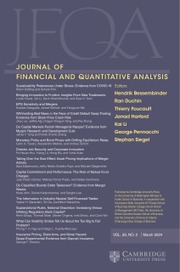Article contents
Predictability in International AssetReturns: A Reexamination
Published online by Cambridge University Press: 06 April 2009
Abstract
This paper argues that inferring long-horizon assetreturn predictability from the properties of vectorautoregressive (VAR) models on relatively shortspans of data is potentially unreliable. Weillustrate the problems that can arise byreexamining the findings of Bekaert andHodrick(1992), who detected evidence of in-samplepredictability in international equity and foreignexchange markets using VAR methodology for a varietyof countries from 1981–1989. The VAR predictions aresignificantly biased in most out-of-sample forecastsand are conclusively outperformed by a simplebenchmark model at horizons of up to six months.This remains true even after corrections for smallsample bias and the introduction Bayesian parameterrestrictions. A Monte Carlo analysis indicates thatthe data are unlikely to have been generated by astable VAR. This conclusion is supported by anexamination of structural break statistics. We showthat implied long-horizon statistics calculated fromthe VAR parameter estimates are very unreliable.
Information
- Type
- Research Article
- Information
- Journal of Financial and Quantitative Analysis , Volume 35 , Issue 4 , December 2000 , pp. 601 - 620
- Copyright
- Copyright © School of Business Administration, University of Washington 2000
Footnotes
Research Department, Federal Reserve Bank of St.Louis. St. Louis, MO 63011, and Department ofFinance, College of Business Administration,University of lowa, lowa city, IA 52240,resepectively. The views expressed are those ofthe authors and do not necessarily reflectofficial positions of the federal Reserve Bank ofSt. Louis or the Federal Reserve System. Theauthors thank Robert Hodrick for supplying thedata used in Bekaert and Hodrick (1992), MorganStanley for providing additional financial data,and Kent Koch for excellent research assistance.We also thank Chuck Whiteman, Dick Anderson, BobRache, Gene Savin, Dan Thornton, and Guofu Zhou(associate editor and referee) for helpfulcomments. We acknowledge Robert Hodrick and PaulSengmuller both for helpful comments and forpointing out a program error. Weller thanks theResearch Department of the Federal Reserve Bank ofSt. Louis for its hospitality during his stay as aVisiting Scholar, when this work wasinitiated.
References
- 31
- Cited by

